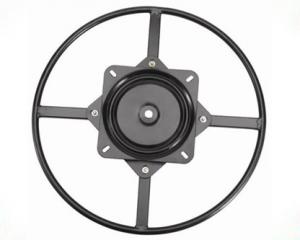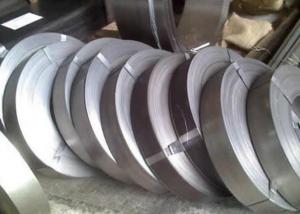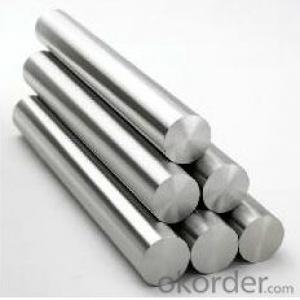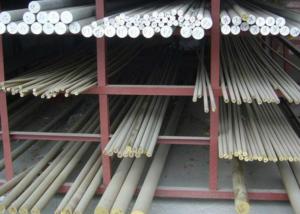SAE 4140 4150 4340 Alloy Steel Round Steel Bar
- Loading Port:
- China main port
- Payment Terms:
- TT OR LC
- Min Order Qty:
- 30 m.t.
- Supply Capability:
- 10000 m.t./month
OKorder Service Pledge
OKorder Financial Service
You Might Also Like
Item specifice
SAE 4140 4150 4340 Alloy Steel Round Steel Bar
Product Information:
1.Grade:SAE8620 SNCM220 805M20 4150 4140 4130 EN24 4340
2.Size: 12mm-300mm
3.Standard Performed: ASTM A29/A29M-04
4.Quality: AISI8620
Chemical Composition(%)
| Grade | C | Si | Mn | P | S | Cr | Ni | Mo |
| 8620 | 0.18-0.23 | 0.15-0.35 | 0.70-0.90 | Max 0.035 | Max 0.035 | 0.40-0.60 | 0.40-0.70 | 0.15-0.25 |
Product Overviews:
| Product Name | Typical Grades | Diameter(mm) | Standard adopted |
| Carbon Steel | 20 (1020/S20C/C22) | Ø16-Ø300 | GB/SAE/JIS/DIN |
| 40 (1040/S40C/C40) | |||
| 45 (1045/S45C/C45) | |||
| Bearing Steel | GCr9 (51100/SUJ1) | Ø12-Ø250 | |
| GCr15 (52100/SUJ2/100Gr6) | |||
| GCr9SiMn (A485-Gr.1/SUJ3) | |||
| Cr-Mo Steel | 20Cr (5120/SCr420H/20Cr4) | Ø12-Ø250 | |
| 40Cr (5140/SCr440/41Cr4) | |||
| 42CrMo(4140/SCM440/42CrMo4) | |||
| Gear Steel | 20CrNiMo | Ø16-Ø600 | |
| 20CrMn(5115/SMnC420/20MnCr5) | |||
| 20CrNiMo(8620/SNCM220/20CrMiMo2) |
Product Show:
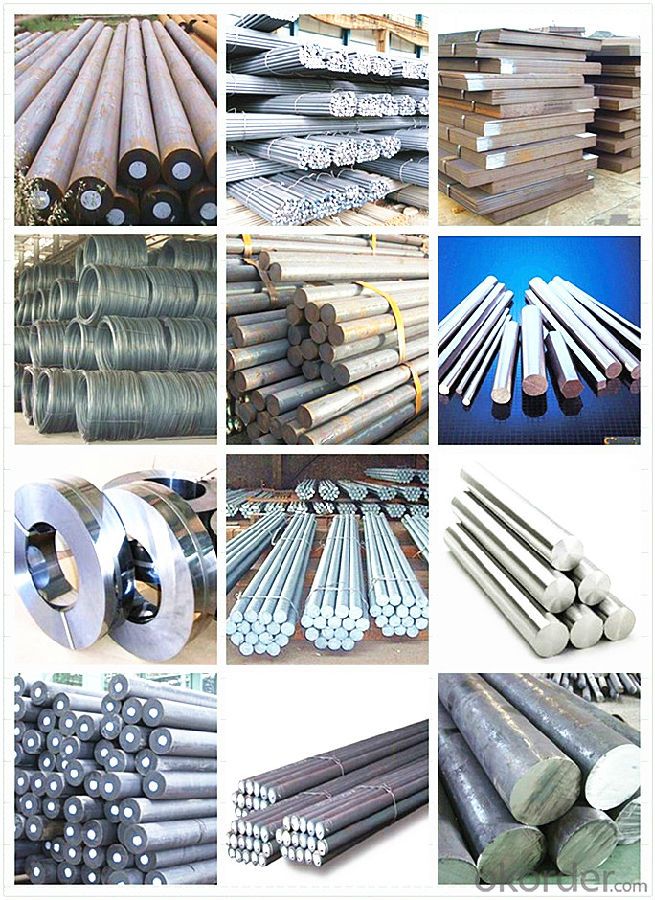
Our Advantages:
· Industry experience over 20 years.
· Shipment of goods -More than 70 countries worldwide.
· The most convenient transport and prompt delivery.
· Competitive price with best service.
· High technical production line with top quality products.
· High reputation based on best quality products.
With our experienced, enthusiastic and dynamic staffs, we assure to bring you the products with best quality, reasonable prices and good after-sales services under the motto: Friends First, Business After.
Communication, Experience, Expertise and Best efforts are our Promises to you.
- Q:What are the characteristics of tool steel?
- Tool steel is a type of steel that possesses several distinctive characteristics. Firstly, it is known for its exceptional hardness, making it highly resistant to wear and abrasion. Additionally, tool steel has excellent toughness and strength, allowing it to withstand high impact forces without fracturing. It also exhibits good heat resistance, retaining its hardness and strength even at elevated temperatures. Another notable characteristic of tool steel is its ability to be easily shaped and machined, making it a preferred choice for manufacturing tools and equipment. Overall, the key attributes of tool steel include hardness, toughness, strength, heat resistance, and machinability.
- Q:What are the challenges in machining special steel alloys?
- Special steel alloys pose several challenges when it comes to machining, primarily due to their unique properties and characteristics. The first major challenge is their high hardness, which is often enhanced through heat treatment to improve mechanical properties. As a result, traditional cutting tools wear out quickly or become dull, making it difficult to machine these alloys. Additionally, the high hardness increases the risk of tool breakage, leading to frequent tool changes and increased production downtime. Another challenge is the presence of abrasive elements in special steel alloys, such as chromium, tungsten, or vanadium. These elements can cause rapid tool wear and degradation, resulting in reduced cutting tool life and higher machining costs. Moreover, if not managed properly during the machining process, these abrasive elements can lead to poor surface finish and dimensional accuracy. Furthermore, special steel alloys have low thermal conductivity, making it challenging to dissipate the heat generated during machining. This can result in high temperatures at the cutting zone, causing thermal expansion and distortion of the workpiece. The heat also affects the cutting tool, reducing its efficiency and lifespan. Effective heat management is crucial to prevent workpiece deformation and maintain dimensional accuracy. Moreover, these steel alloys are prone to work hardening, meaning they become harder and more difficult to cut as the machining process progresses. Work hardening leads to increased cutting forces, tool wear, and reduced surface finish. To overcome this challenge, machining parameters such as cutting speed, feed rate, and depth of cut must be carefully optimized to avoid excessive work hardening. In conclusion, machining special steel alloys involves overcoming challenges such as high hardness, abrasive elements, low thermal conductivity, and work hardening. To address these challenges effectively, manufacturers need to use specialized cutting tools, efficient cooling and lubrication systems, optimize machining parameters, and carefully select machining strategies. By doing so, accurate and efficient machining of special steel alloys can be achieved.
- Q:What are the challenges in machining high-speed special steel?
- Machining high-speed special steel poses several challenges due to its unique properties and characteristics. One of the main challenges is its extreme hardness, which makes it difficult to cut and shape. High-speed special steel typically has a high carbon content and is heat-treated to enhance its hardness, which results in increased wear on cutting tools. The high hardness of this steel also leads to increased heat generation during machining, which can cause thermal distortion and affect the dimensional accuracy of the finished product. This requires the use of specialized cooling techniques and cutting tools with advanced coatings to dissipate heat and maintain stability. Another challenge is the brittleness of high-speed special steel. It tends to have low toughness and is prone to cracking and chipping during machining operations. This requires careful selection of cutting parameters, such as cutting speed, feed rate, and depth of cut, to prevent excessive stress and minimize the risk of tool failure. Additionally, high-speed special steel often contains alloying elements like tungsten, vanadium, and cobalt, which can further complicate the machining process. These elements increase the strength and wear resistance of the steel but also make it more challenging to machine. Specialized tool materials and cutting strategies are required to effectively machine these alloys and achieve desired surface finishes. Furthermore, the cost of high-speed special steel can be significantly higher than conventional steels, which adds to the challenges of machining. The high tooling costs associated with cutting tools necessary to machine this steel can be a significant investment. Overall, machining high-speed special steel requires advanced cutting techniques, specialized tooling, and careful consideration of cutting parameters to overcome the challenges posed by its extreme hardness, brittleness, and alloying elements.
- Q:How does special steel contribute to sustainable construction?
- Special steel contributes to sustainable construction in several ways. Firstly, it has a significantly longer lifespan compared to other construction materials, reducing the need for frequent repairs or replacements. This leads to reduced resource consumption and waste generation. Additionally, special steel is highly durable and resistant to corrosion, making it an ideal choice for structures in harsh environments, such as bridges or offshore wind farms. This longevity and resilience reduce the environmental impact associated with the maintenance and replacement of infrastructure. Furthermore, special steel can be recycled and reused multiple times without losing its properties, reducing the demand for virgin materials and minimizing the carbon footprint of construction projects. Overall, the use of special steel in construction helps promote sustainability by increasing the lifespan of structures, reducing resource consumption, and minimizing waste generation.
- Q:Can special steel be used in marine environments?
- Yes, special steel can be used in marine environments. Special steel, such as stainless steel or marine-grade steel, is specifically designed to withstand the harsh conditions of marine environments. These environments typically involve exposure to saltwater, which can be highly corrosive for many types of materials. However, special steel is resistant to corrosion due to its high levels of chromium and other alloying elements. This makes it highly suitable for various marine applications, including shipbuilding, offshore structures, and marine equipment. Special steel offers excellent strength, durability, and corrosion resistance, making it a reliable choice for marine environments. Additionally, special steel can be further treated and coated to enhance its resistance to corrosion, ensuring its longevity and performance in marine conditions.
- Q:What are the main advantages of using special steel in aerospace applications?
- The main advantages of using special steel in aerospace applications are its high strength-to-weight ratio, excellent corrosion resistance, and exceptional fatigue resistance. These properties make special steel ideal for withstanding the extreme conditions of aerospace environments, ensuring the safety and longevity of aircraft components. Additionally, special steel can be easily machined and welded, allowing for intricate designs and efficient manufacturing processes in the aerospace industry.
- Q:How is special steel used in the construction of buildings and bridges?
- Special steel is used in the construction of buildings and bridges primarily due to its high strength and durability. It is commonly used for structural elements like beams, columns, and trusses, as well as for reinforcement purposes. Special steel alloys have superior properties, such as increased resistance to corrosion, heat, and impact, making them ideal for withstanding the heavy loads and harsh environmental conditions that buildings and bridges encounter. Additionally, special steel can be fabricated into various shapes and sizes, allowing for flexibility in design and ensuring structural integrity.
- Q:What are the different methods of joining special steel components?
- There are several methods of joining special steel components, each with its own advantages and applications. Some of the most common methods include welding, brazing, soldering, and mechanical fastening. 1. Welding: Welding is one of the most widely used methods for joining special steel components. It involves melting the base metals and adding a filler material to create a strong bond. Different welding techniques, such as arc welding, gas welding, or laser welding, can be used depending on the specific requirements and properties of the steel components. 2. Brazing: Brazing is a joining process that uses a filler material with a lower melting point than the base metals. The filler material is heated and distributed between the components, creating a strong bond when it solidifies. Brazing is often used for high-temperature applications and can be done with a torch, furnace, or induction heating. 3. Soldering: Soldering is similar to brazing but uses a lower melting point filler material called solder. It is commonly used for electrical and electronic applications, as well as for joining small or delicate steel components. Soldering requires less heat and can be done with a soldering iron or a hot air gun. 4. Mechanical Fastening: Mechanical fastening involves joining components using mechanical means such as screws, bolts, nuts, or rivets. This method is often used when disassembly or reassembly is required, as it allows for easy removal and replacement of components. Mechanical fastening is suitable for applications where a strong and reliable joint is needed but welding or brazing may not be feasible. 5. Adhesive Bonding: Adhesive bonding is another method used for joining special steel components. It involves applying an adhesive material to the mating surfaces and allowing it to cure or harden, creating a strong bond. Adhesive bonding is often used when a continuous joint is required or when joining dissimilar materials. It is also advantageous for applications that require vibration damping or sealing. Each method of joining special steel components has its own strengths and limitations, and the selection of the appropriate method depends on factors such as the specific requirements of the application, the properties of the steel components, and the desired strength and durability of the joint.
- Q:How does special steel perform under high temperatures?
- Special steel is specifically designed to perform exceptionally well under high temperatures. It exhibits excellent strength, hardness, and resistance to deformation, even when exposed to extreme heat. Additionally, special steel demonstrates remarkable resistance to oxidation and corrosion, making it highly suitable for applications that involve high temperatures, such as in the aerospace, automotive, and power generation industries.
- Q:What are the different heat treatment processes used in special steel?
- Some of the different heat treatment processes used in special steel include annealing, normalizing, tempering, quenching, and case hardening.
1. Manufacturer Overview |
|
|---|---|
| Location | |
| Year Established | |
| Annual Output Value | |
| Main Markets | |
| Company Certifications | |
2. Manufacturer Certificates |
|
|---|---|
| a) Certification Name | |
| Range | |
| Reference | |
| Validity Period | |
3. Manufacturer Capability |
|
|---|---|
| a)Trade Capacity | |
| Nearest Port | |
| Export Percentage | |
| No.of Employees in Trade Department | |
| Language Spoken: | |
| b)Factory Information | |
| Factory Size: | |
| No. of Production Lines | |
| Contract Manufacturing | |
| Product Price Range | |
Send your message to us
SAE 4140 4150 4340 Alloy Steel Round Steel Bar
- Loading Port:
- China main port
- Payment Terms:
- TT OR LC
- Min Order Qty:
- 30 m.t.
- Supply Capability:
- 10000 m.t./month
OKorder Service Pledge
OKorder Financial Service
Similar products
New products
Hot products
Related keywords























